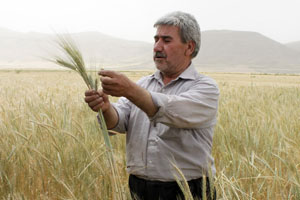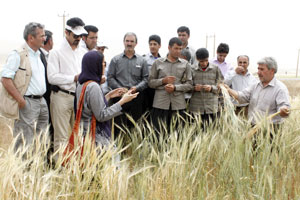Rapidly increasing on-farm biodiversity is a matter of urgency in an era of climate change. Farmers often have limited access to genetic resources. Not only do they need greater access to the genetic material in research stations and gene banks, they also need to collaborate with scientists who are willing and able to work together with them to create new knowledge. The Evolutionary Plant Breeding programme in Iran is one example of what can be achieved when these challenges are overcome.

Access to genetic resources and genuine collaboration with scientists is lacking in most parts of the world. The Centre for Sustainable Development (CENESTA) in Iran developed a model that has given a large number of farmers access to a great amount of biodiversity in a relatively short time: Evolutionary Plant Breeding (EPB).
A dynamic and inexpensive strategy, EPB rapidly enhances the adaptation of farmers’ crops to climate change. It builds on our experience with Participatory Plant Breeding (PPB), where farmers plant a number of different varieties of the same crop and, after several years of selection, choose a small number of varieties for multiplication and use. In EPB, farmers start planting a much larger mixture of hundreds or thousands of different varieties, and do not necessarily aim to arrive at single varieties.
Our ideas evolve, as do our seeds
EPB relies on mixing as many different types of a particular crop as possible, and leaving them to cross freely between each other. Genetically, the seed which is harvested is never exactly the same as the seed which was planted.
Several farmers in different regions plant and harvest a small sample of seed (4-5 kg) in the same 250 m2 plot for successive years. These plant populations then evolve under different types of agronomic management and in the face of specific combinations of stress from diseases, insects, weeds, drought, extreme temperatures and salinity. In this way, the frequency of genotypes adapted to local conditions gradually increases.
The idea of EPB is not new. As early as 1929, methods were developed for generating heterogeneous populations of barley where locally adapted varieties were needed. In 1956, the idea was labelled as the “evolutionary plant breeding method”. Yet already in 1956 there was a strong demand for uniformity in the most important food and feed crops. This was driven by the growing use of chemical inputs, which required uniformity to give a consistent response. In addition, emerging seed companies attempted to protect their breeding programmes and associated products by promoting this uniformity. Therefore it was only in 2008 that EPB was first implemented in a formal project.
Before CENESTA launched participatory breeding projects, all the breeding programmes in Iran had excluded farmers from the most important stages of the breeding process, and farmers often did not adopt the products of these programmes. EPB follows a completely different approach, with farmers at the centre of producing new varieties and applying the principles of natural selection themselves.
Sowing the seeds of success
“Farmers can guide the evolution of their crop mixtures”
In 2008, with support from Dr Salvatore Ceccarelli, CENESTA started with EPB by providing five farmers in Kermanshah and Semnan provinces with mixtures of, 1,600 different types of barley supplied by the International Center for Agricultural Research in the Dry Areas (ICARDA).
This mixture included a wide range of germplasm: the wild progenitor, Hordeum spontaneum, landraces from several countries and modern breeding material. Within such an “evolutionary” mixture different plants cross naturally to produce new types. Each year, the types produce more seed and gradually the population becomes better adapted to the specific and changing circumstances of farmers.
The success of EPB spread far beyond these first five farmers. Based on the success of the barley population, the Dryland Agricultural Research Institute (DARSI) established a similar programme for bread wheat. Evolutionary populations of a variety of crops are now also grown in several other countries. Also, the Iranian farmers of the first years were so satisfied with the population’s performance that they shared their mixtures of barley with other farmers in four other provinces, through CENESTA’s PPB programme and also informally with neighbours, friends and relatives. The populations now cover several hundred hectares and are planted in 17 provinces by about 150 farmers.
Living gene banks
“Thirty years ago we used to have many different varieties,” said Abdol-Reza Biglari, a farmer in Garmsar. “Most of the new varieties introduced to us were not suitable for more than one or two years. This shows that we have to return to biodiversity.” Gene banks perform an important role in the conservation of species, but they freeze not only seeds but also their evolution at the time of collection. Local varieties and wild relatives must also be conserved in situ. By combining participation and evolution in breeding programmes, farmers can guide the evolution of their crop mixtures in the most desirable way for them.
The evolutionary populations can be considered as a living gene bank. Farmers (by themselves or with scientists) select the most desirable plants and use them in participatory breeding programmes. For farmers who prefer to sow mixtures rather than single varieties, the evolutionary populations serve as a source of genetic resources for creating new mixtures. The importance of having secure access to such a collection of seeds became apparent in Jordan, for instance, where farmers and scientists turned to evolutionary populations once the civil war in Syria disrupted their regular source of breeding materials. Farmers become the owners of their future: with the best varieties evolving in their fields, there is less, or no, need to buy seeds.
Better seeds

Nemat Salemian, a farmer in Anjirak, recalls his first encounter with EPB. “We received this wheat from another farmer who told us that it’s a mixture of hundreds of different varieties and that we should plant it in our worst soil. My father said that in the 80 years that he has been a farmer, he has never seen better plants, despite the very bad soil and the climatic conditions this year.”
The EPB mixtures have been shown to produce higher yields and perform better in adverse conditions than their local or improved counterparts. Despite late sowing, in the first year of CENESTA’s programme, the evolutionary populations of barley out-yielded the local barley and performed almost as well as the improved barley cultivar. In the following year, the evolutionary populations of wheat yielded more than twice as much as the local varieties.
The EPB populations are also more resistant to weeds, diseases and pests. In 2011-2012, a farmer in the district of Garmsar witnessed that his evolutionary population of wheat had higher yields than the local improved variety and the evolutionary population did not need to be treated with pesticides and herbicides. This suggests that evolutionary populations could be very useful in organic agriculture and cheaper to grow.
Farmers can face some challenges with EPB. Very small plots of land may not be enough to grow their own evolutionary population. To resolve this, in a community of small farmers the evolutionary population could rotate among them. Also, in the case of severe climatic events, only a small fraction of the population may survive – leaving too little diversity in the mixture to continue to adapt. In this case it may be necessary to supplement the mixture with new types. Nevertheless, in such circumstances the farmers growing the evolutionary population will have more chance of harvesting some of their crops, while fields with only one variety may be entirely destroyed.
After receiving a small amount of seed in the first year of the EPB trials, we expected farmers to continue to sow just enough to allow the population to evolve and to act as a source of locally adapted varieties.
One of the most unexpected outcomes of the evolutionary population trials was that some farmers decided to sow all the seed they had harvested, multiplying and cultivating the seed as their main crop.
“About 20 farmers have asked me for this seed, after they saw it in my field last year,” Faraj Safari recalls. “This year I am only going to grow this mixture. I’m going to plant about 40 hectares with this mixture. I can give seed to about 10 or 15 other farmers this year, and more next year.”
The question of the consumer
Many people are concerned if the final product from EPB mixtures is of a suitable quality to use and sell. In Iran, with wheat and barley, there has been no reason for worry. A protein analysis of the barley varieties, which are mostly used as an animal feed in Iran, showed that the evolutionary population had more protein than the local improved variety. For wheat, farmers and bakers have been pleased with the bread they made from the evolutionary populations. Some are even marketing the bread in local artisanal bakeries. Farmers growing evolutionary populations in France and Italy confirmed that creating mixtures not only brings greater yield stability, but also greater aroma and quality to the bread.
The suitability of evolutionary populations as the main crop depends on the use of the crop and the cultural preferences of farmers and consumers. Even when the crop does not lend itself to being consumed as a mixture (as with many vegetable varieties), the evolutionary populations still serve as living gene banks for farmers to source individual varieties. The use of EPB with vegetables is currently underway in Italy with tomato, beans and courgettes.
Where next?
The evolutionary populations of wheat and barley continue to be spread throughout Iran, both through farmer-to-farmer exchanges and through exchanges organised by DARSI, the Department of Agriculture of Fars Province, and CENESTA. The main challenge is to keep up with the fast spread of these seeds, to track the spread and the outcomes and to support farmers.
The first national workshop on EPB was organised in Shiraz in January 2013 where farmers from several provinces shared their experiences. Regular local, regional and national workshops and field visits are needed to strengthen farmers’ knowledge about how to use these populations. At the same time, we must try to develop awareness of the potential impacts of different seed laws and policies on farmers’ rights to save, exchange, develop and sustainably use their seeds.
Maryam Rahmanian, Maede Salimi, Khadija Razavi, Dr Reza Haghparast and Dr Salvatore Ceccarelli
Maryam Rahmanian (maryam@cenesta.org) and Maede Salimi (maede@cenesta.org) are Research Associates at CENESTA. Khadija Razavi (khadija@cenesta.org) is CENESTA’s Executive Director. Dr Reza Haghparast is the Head of the Rainfed Cereals Department at DARSI in Kermanshah, Iran (r.haghparast@areo.ir). Dr Salvatore Ceccarelli is a consultant at ICARDA (s.ceccarelli@cgiar.org).
To read more on EPB in Iran, visit www.cenesta.org.

